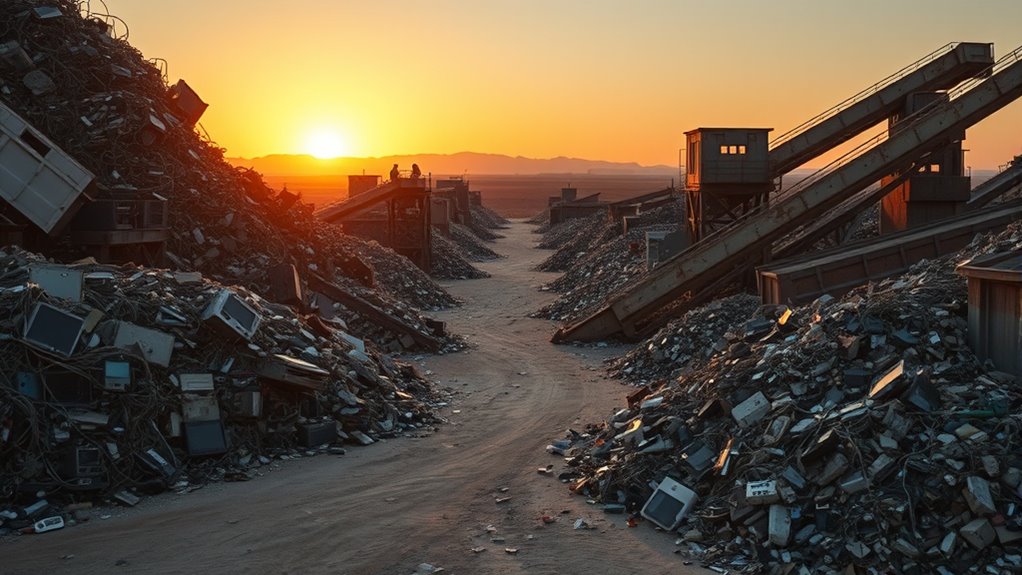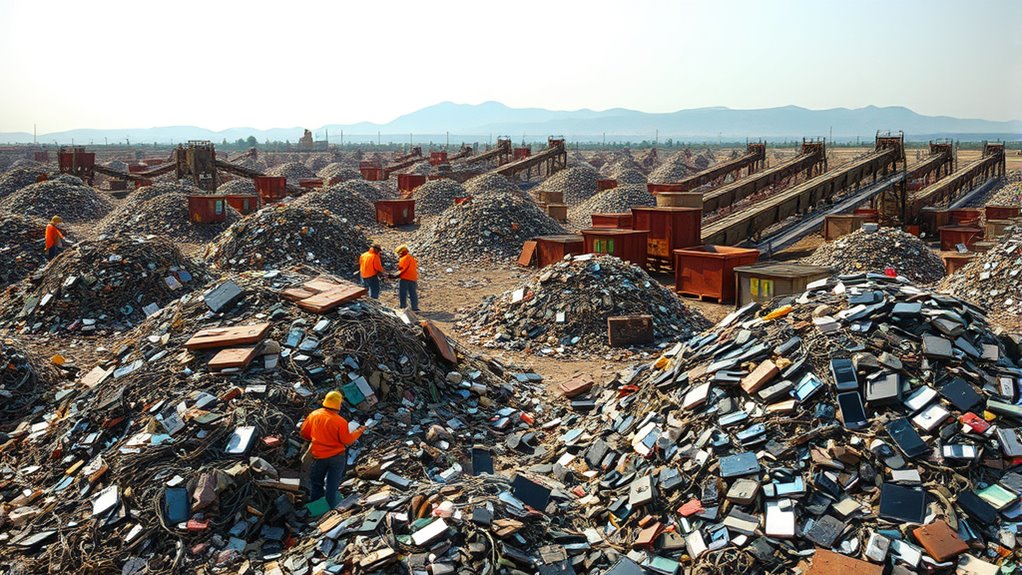When you dispose of old gadgets, they usually head to recycling centers that recover valuable materials and dispose of hazardous parts responsibly. Not all centers handle e-waste correctly, so some devices may end up causing environmental harm. Reputable recyclers use advanced tech to securely erase data and extract metals, plastics, and rare elements. If you’re curious about where your old devices go and how they’re transformed, there’s more to uncover about responsible e-waste recycling.
Key Takeaways
- Most e-waste is sent to specialized recycling centers that recover valuable materials and safely dispose of hazardous components.
- Responsible recyclers employ advanced methods like secure data wiping and physical destruction to protect personal privacy.
- Innovative automated systems improve efficiency, accurately separating plastics, metals, and rare earth elements from gadgets.
- Proper recycling reduces environmental harm by minimizing mining, repurposing materials, and supporting sustainability efforts.
- Not all e-waste is managed responsibly; choosing certified recyclers ensures gadgets are properly processed and recycled.

Have you ever wondered what happens to your old gadgets once you toss them out? It’s easy to assume they simply disappear or end up in a landfill, but the reality is more complex—and more concerning—when it comes to data privacy and recycling innovation. When you discard electronic devices, they often find their way to specialized recycling centers that aim to recover valuable materials and prevent environmental harm. However, not all e-waste is handled responsibly, and this can pose risks to your personal information and the planet.
Data privacy is a vital issue in e-waste recycling. Many devices still contain sensitive data—photos, banking information, corporate files—that can be accessed if proper data destruction isn’t performed. Unfortunately, some informal or poorly managed recycling operations neglect this step, leading to potential data breaches. That’s why reputable recycling centers employ advanced methods to securely wipe or physically destroy storage components, ensuring your personal information can’t be recovered. When you choose certified e-waste recyclers, you’re not only helping the environment but also safeguarding your privacy. They utilize recycling innovation—new technologies and processes—that make data destruction more efficient and thorough. These innovations include shredding devices that destroy hard drives beyond recovery and software solutions that permanently erase stored data, minimizing the risk of identity theft or data leaks.
Reputable recyclers use advanced methods to securely destroy data, protecting your privacy and preventing identity theft.
Recycling innovation has also transformed how electronic waste is processed. Traditional methods often relied on manual dismantling, which was slow, hazardous, and environmentally damaging. Today, automated systems use robotics and smart sorting technologies to separate plastics, metals, and circuit boards more accurately and safely. This reduces the exposure of workers to toxic substances and speeds up the recycling process. Additionally, these innovations enable the extraction of rare earth elements and precious metals that would otherwise be lost or dumped in landfills. As a result, fewer raw materials need to be mined, conserving natural resources and reducing energy consumption.
When your old gadgets are properly recycled, they don’t simply vanish—they’re transformed. Valuable metals are recovered, reducing the need for mining, while plastics and other materials are repurposed into new products. This circular approach is at the heart of recycling innovation, turning electronic waste into a resource rather than a problem. Proper handling and advanced recycling technology are essential to maximizing recovery and minimizing environmental impact. Still, the effectiveness of this process depends heavily on where and how your devices are recycled. By supporting certified recyclers that prioritize data privacy and leverage the latest recycling technology, you play an essential role in reducing environmental impact and protecting your personal data. So next time you upgrade your device, remember: responsible recycling is more than just tossing it in the bin. It’s about making sure your old gadgets are handled with care and innovation, turning e-waste into a sustainable resource for the future.
Frequently Asked Questions
How Can Consumers Verify a Recycling Facility’S Legitimacy?
To verify a recycling facility’s legitimacy, you should check their certification standards, such as R2 or e-Stewards, which ensure proper e-waste handling. Look for transparency in their recycling process, including clear reporting and responsible disposal practices. You can also research their reputation and ask for proof of compliance. Doing this helps you guarantee your gadgets are recycled ethically and safely, reducing environmental impact and avoiding illegal dumping.
What Are the Environmental Impacts of Improper E-Waste Disposal?
When you improperly dispose of e-waste, you risk causing serious environmental harm. Mercury contamination can seep into water sources, poisoning wildlife and humans. Soil pollution from hazardous materials damages ecosystems and makes land unusable for agriculture. Your actions can inadvertently contribute to these issues, so always make certain you dispose of e-waste responsibly and support recycling programs that prevent harmful substances from polluting the environment.
Are There Any New Technologies Improving E-Waste Recycling?
You’re in the know now that new tech is transforming e-waste recycling. Innovative techniques, like chemical separation and robotics, act like a gust of fresh air, making processes faster and more precise. Automation advancements reduce human error and improve recovery of valuable materials. These innovations help keep e-waste out of landfills, turning old gadgets into resources, and showing that even in trash, there’s hope for a cleaner planet.
How Does E-Waste Recycling Vary Between Countries?
You should know that e-waste recycling varies widely between countries due to different cross border regulations and recycling standards. Some nations enforce strict laws and have advanced facilities, ensuring proper disposal and resource recovery. Others lack regulations, leading to illegal dumping or unsafe recycling practices. Your awareness of these differences helps you understand why responsible e-waste management is essential worldwide, influencing global efforts to reduce environmental harm and promote sustainable practices.
What Incentives Exist for Individuals to Recycle Old Gadgets?
You’re likely motivated to recycle your old gadgets because of monetary incentives and increased environmental awareness. Many programs offer cash or discounts, making recycling financially appealing. Additionally, knowing that recycling helps reduce pollution and conserve resources encourages you to participate. These incentives create a win-win situation, inspiring you to do your part for the planet while gaining tangible benefits. Your actions can make a meaningful difference in sustainable waste management.
Conclusion
Now that you know where your old gadgets end up, you can make smarter choices. Remember, not all e-waste gets recycled properly—some still end up in places like the bustling markets of Akihabara, just like in the good old days. By staying informed and responsible, you can help guarantee your tech’s final journey isn’t a dark secret but a step toward a cleaner planet. Together, we can turn the tide and give e-waste a better fate.









